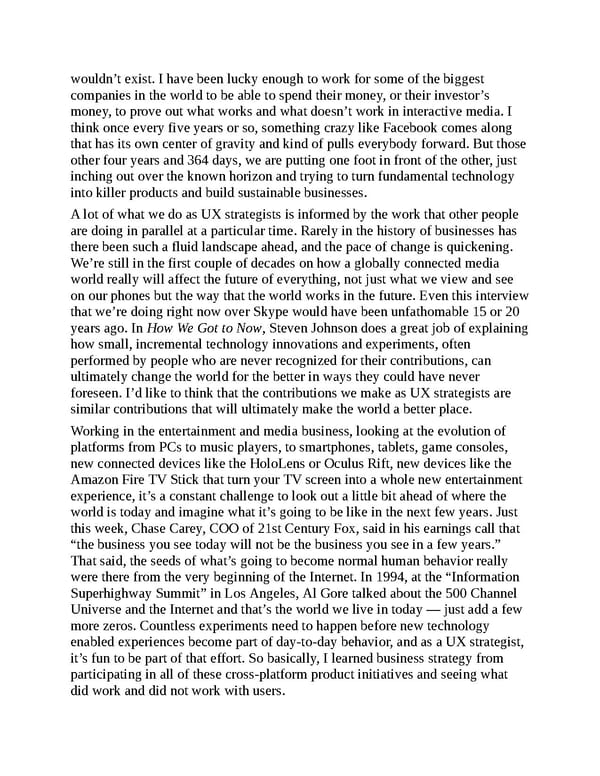wouldn’t exist. I have been lucky enough to work for some of the biggest companies in the world to be able to spend their money, or their investor’s money, to prove out what works and what doesn’t work in interactive media. I think once every five years or so, something crazy like Facebook comes along that has its own center of gravity and kind of pulls everybody forward. But those other four years and 364 days, we are putting one foot in front of the other, just inching out over the known horizon and trying to turn fundamental technology into killer products and build sustainable businesses. A lot of what we do as UX strategists is informed by the work that other people are doing in parallel at a particular time. Rarely in the history of businesses has there been such a fluid landscape ahead, and the pace of change is quickening. We’re still in the first couple of decades on how a globally connected media world really will affect the future of everything, not just what we view and see on our phones but the way that the world works in the future. Even this interview that we’re doing right now over Skype would have been unfathomable 15 or 20 years ago. In How We Got to Now, Steven Johnson does a great job of explaining how small, incremental technology innovations and experiments, often performed by people who are never recognized for their contributions, can ultimately change the world for the better in ways they could have never foreseen. I’d like to think that the contributions we make as UX strategists are similar contributions that will ultimately make the world a better place. Working in the entertainment and media business, looking at the evolution of platforms from PCs to music players, to smartphones, tablets, game consoles, new connected devices like the HoloLens or Oculus Rift, new devices like the Amazon Fire TV Stick that turn your TV screen into a whole new entertainment experience, it’s a constant challenge to look out a little bit ahead of where the world is today and imagine what it’s going to be like in the next few years. Just this week, Chase Carey, COO of 21st Century Fox, said in his earnings call that “the business you see today will not be the business you see in a few years.” That said, the seeds of what’s going to become normal human behavior really were there from the very beginning of the Internet. In 1994, at the “Information Superhighway Summit” in Los Angeles, Al Gore talked about the 500 Channel Universe and the Internet and that’s the world we live in today — just add a few more zeros. Countless experiments need to happen before new technology enabled experiences become part of day-to-day behavior, and as a UX strategist, it’s fun to be part of that effort. So basically, I learned business strategy from participating in all of these cross-platform product initiatives and seeing what did work and did not work with users.
 UX Strategy: How to Devise Innovative Digital Products that People Want Page 314 Page 316
UX Strategy: How to Devise Innovative Digital Products that People Want Page 314 Page 316